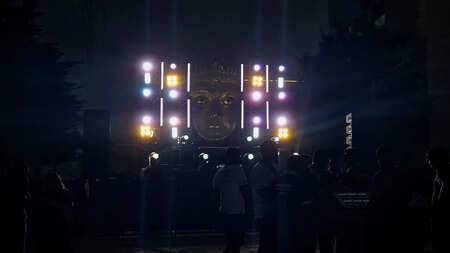The evolution of techno music
Times of Bennett | Updated: May 16, 2023 15:17

By Pushp Sharma
With its futuristic sounds and throbbing beats, techno music has sparked a global cultural movement. Techno was born in the underground clubs of Detroit in the 1980s, and it has since influenced music all around the world. This blog will examine the development of the genre of techno music, tracing its origins, analysing its effects on various locales and emphasising the variety of subgenres that have developed along the way.
The Origins of Techno: In response to the city's social upheaval and economic downfall, techno music first appeared in Detroit, Michigan, in the middle of the 1980s. To develop a distinctive genre known for its powerful beats and synthesised melodies, pioneering musicians like Juan Atkins, Derrick May, andKevin Saunderson blended electronic music, funk, and futuristic sounds. An outlet for expression, experimentation, and a sense of community was provided by the early techno culture.
Techno Music's Expansion AcrossEurope : Techno music made its way to Europe in the late 1980s and early 1990s, where it swiftly became well-liked. In locations like Berlin, Frankfurt, and London, the techno movement gained traction as DJs and producers gave the genre their own spins. Berlin's metamorphosis into a techno metropolis, powered by renowned clubs like Tresor and Berghain, began when the Berlin Wall fell in 1989.
Regional Variations : As techno music gained popularity around the world, several areas started to add their own cultural elements to the genre. Breakbeats and hardcore techno were experimented with by artists in the UK, giving rise to genres like jungle and drum and bass. The New Beat trend, with its slower tempos and darker, industrial sounds, arose in Belgium. The Netherlands, Spain, and Italy all evolved their own distinctive styles and scenes in a similar manner.
Techno in the Americas : The Americas saw the arrival of techno music, which flourished and developed there after finding an accepting audience. Techno flourished in American locations like Chicago, New York, and Miami, where DJs and producers infused the music with their unique styles. TheDetroit Electronic Music Festival , which is now known as Movement, first appeared in 2000, helping to establish techno's dominance in North America. Brazil and Argentina are two South American nations that have embraced techno, organising energetic festivals and developing homegrown talent.
Fusion and Subgenres: As techno music developed, it merged with other genres and gave rise to a variety of subgenres. The rhythmic aspects of techno were combined with the grooves and soulful tones of house music to create tech-house. With a concentration on repeated patterns and minimalist compositions, minimal techno cut the sound down. Industrial techno is a darker and more violent subgenre of techno that also combined with industrial music. These subgenres demonstrated the genre's adaptability and provided space for additional exploration and creativity.
To become a universal phenomenon, techno music has crossed national boundaries, cultural barriers, and linguistic barriers. Techno has impacted every continent since its humble beginnings in Detroit, adjusting to local cultures and tastes while preserving its fundamental elements. Numerous subgenres have emerged as a result of the genre's development, each with its own unique traits and following. Techno, which is still developing, is a major force in the field of electronic music, bringing people together and influencing nightlife all over the world.
With its futuristic sounds and throbbing beats, techno music has sparked a global cultural movement. Techno was born in the underground clubs of Detroit in the 1980s, and it has since influenced music all around the world. This blog will examine the development of the genre of techno music, tracing its origins, analysing its effects on various locales and emphasising the variety of subgenres that have developed along the way.
The Origins of Techno: In response to the city's social upheaval and economic downfall, techno music first appeared in Detroit, Michigan, in the middle of the 1980s. To develop a distinctive genre known for its powerful beats and synthesised melodies, pioneering musicians like Juan Atkins, Derrick May, and
Techno Music's Expansion Across
Techno in the Americas : The Americas saw the arrival of techno music, which flourished and developed there after finding an accepting audience. Techno flourished in American locations like Chicago, New York, and Miami, where DJs and producers infused the music with their unique styles. The
Fusion and Subgenres: As techno music developed, it merged with other genres and gave rise to a variety of subgenres. The rhythmic aspects of techno were combined with the grooves and soulful tones of house music to create tech-house. With a concentration on repeated patterns and minimalist compositions, minimal techno cut the sound down. Industrial techno is a darker and more violent subgenre of techno that also combined with industrial music. These subgenres demonstrated the genre's adaptability and provided space for additional exploration and creativity.
To become a universal phenomenon, techno music has crossed national boundaries, cultural barriers, and linguistic barriers. Techno has impacted every continent since its humble beginnings in Detroit, adjusting to local cultures and tastes while preserving its fundamental elements. Numerous subgenres have emerged as a result of the genre's development, each with its own unique traits and following. Techno, which is still developing, is a major force in the field of electronic music, bringing people together and influencing nightlife all over the world.







